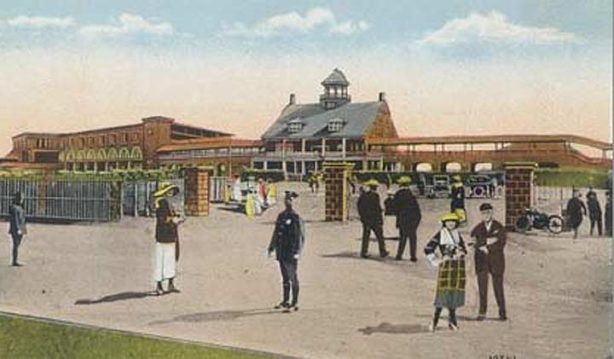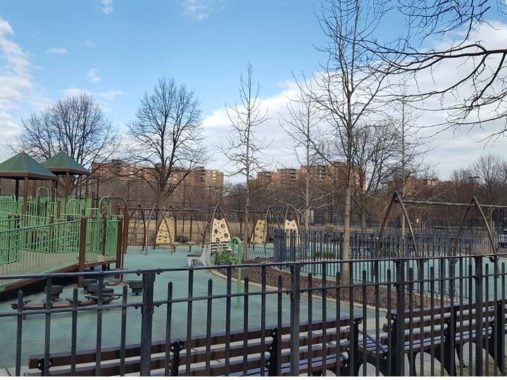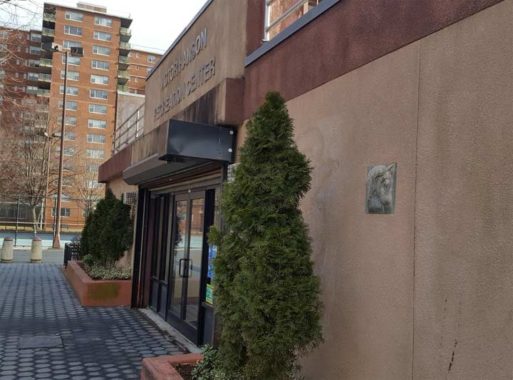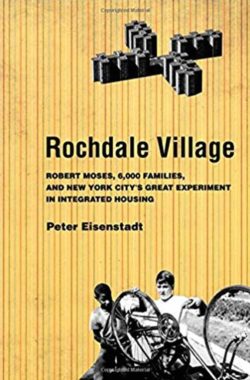By SERGEY KADINSKY
Forgotten NY correspondent
There is so much that can be said about Rochdale Village, the 120-acre co-op in southeastern Queens that was built on the site of a horse racing track. Its appearance is reminiscent of other co-op superblocks built in the postwar decades to keep the middle class in the city such as Penn South, Big Six, Stuy Town, Parkchester, and Electchester.

Upon its opening in late 1963, Rochdale Village was promoted as a model of racial harmony in the midst of civil rights protests nationwide. The reality that black workers were barred from the project and the quota that limited the number of black residents, within a decade led to controversies over busing, blockbusting, white flight, deferred maintenance, a security guard strike of 1978, and crime. In this century, the 20-tower complex is on the rebound, seen as a redoubt of affordable housing in a city that has become quite expensive.

The superblock’s story begins in 1903 when the Metropolitan Jockey Club built The Jamaica Racetrack at Locust Manor, at the time a rural expanse that had recently been absorbed by the city. It operated through 1959. Despite its popularity the course was aging and the state decided to sell it with the proceeds used to refurbish the nearby Aqueduct and Belmont courses. Ahead of its closing, the city’s construction coordinator Robert Moses contemplated a public housing project, community college, and Dodgers stadium at the site before teaming up with co-op developer Abraham Kazan and architect Herman Jessor to build Rochdale Village. Its namesake is an English town where the modern co-op movement began in 1844. It’s pronounced ROSH-dale.

Although the Corbusian superblock features plenty of green space between its apartments and schools, there is also the 8.83-acre city-operated Rochdale Park in the center of this “village.” The park has a playground, ballfield, tennis courts, and the Vic Hanson Recreation Center. Had the co-op kept the site’s history in mind, one can imagine the paths and buildings here named after the various handicaps and stakes that it hosted, or memorable horse names. Not a trace of the racecourse remains at Rochdale Village.

But on the walls of the Vic Hanson Recreation Center one can find square relief panels with horses, likely an architect’s nod to the long-gone racecourse. It is the only physical hint in the entire Rochdale Village of its horse-racing past. An online search for the namesake yielded the longtime Syracuse University football coach who also played baseball and professional basketball. But he had no connection to Queens and I knew that he has as much chance of being the center’s namesake as the conservative writer Victor Davis Hanson. A blurb from the Daily News dated Dec. 11, 1985 revealed a namesake with local roots. This Vic Hanson was a boxing coach, who also happened to play baseball and basketball.

On its official map the park is a green rectangle enveloped by Rochdale Village with a panhandle connecting it to Guy R. Brewer Boulevard. The panhandle’s lawn and trees are nearly indistinct from the co-op’s lawn and trees. If one is looking for a city park enveloped entirely in private property, that distinction goes to Calvary Monument, a .05-acre green space with a monument located inside Calvary Cemetery. Kevin was there in 2011.

There is so much more that can be written about Rochdale Village and its environs, such as two former synagogues that are now churches, its three public schools, police precinct, power plant, two shopping centers, and two other public playgrounds.

I can also refer readers to transit historian Joe Raskin, who grew up in Rochdale Village with promises of the E subway line reaching his home. That tunnel dead-ends beneath York College. This village is best reached by Guy R. Brewer Boulevard, one of a handful of city streets that has a full name. One can also take the train to the Locust Manor station as Kevin did in 2005. but my top source on this co-op is Peter Eisenstadt. He wrote the book on it. The co-op also has a detailed 50th anniversary journal from 2013 filled with tidbits on this unique residential community.
Sergey Kadinsky is the author of Hidden Waters of New York City: A History and Guide to 101 Forgotten Lakes, Ponds, Creeks, and Streams in the Five Boroughs (2016, Countryman Press) and the webmaster of Hidden Waters Blog.
Check out the ForgottenBook, take a look at the gift shop, and as always, “comment…as you see fit.”
2/19/19


18 comments
Neither Stuyvesant Town nor Parkchester were developed as co-ops or by unions. They were built by & owned by Metropolitan Life Ins. Met Life eventually sold Stuyvesant Town & Peter Cooper Village in the early 2000s.
Revised
Never knew it had been a site for a proposed stadium for the Dodgers.
Walter O’Malley wouldn’t have gone for it, anyhow. It was the LIRR Brooklyn Terminal area (about where Barclays Center is), or nothing, if he were going to stay in NY, which he wasn’t all that keen on in the first place.
It would have been interesting because just east of that was Brooklyn’s meat wholesaling and slaughterhouse district along Atlantic Avenue east of Fort Greene Place, which was there until the early 1970s.
See pg. 56 in Peter Eisenstadt’s book on Rochdale Village to read about the failed plan to bring the Brooklyn dodgers to southeast Queens.
My aunt Martha used to live in Rochdale Village, and when my mom wanted to visit, we’d take the bus from Rosedale to Rochdale Village to visit her. Loved visiting her. And sometimes we’d all take the bus that was right outside her building and head on to Jamaica.
I grew up here in 80s and 90s. It was a great place to grow up. Everyone pronounced it ROTCH-dale. Never once heard anybody say ROSH-dale.
it is indeed pronounce rotchdale. i live in the english rochdale. and its shit
What an unfortunate name! I refer to any of the city’s “public” housing projects as “Roach-dale Village(s)”.
I never realized all the history associated with Rochdale village. Thank you for sharing, it’s been so long!
There was a lot of white flight in the aftermath of the Clifford Glover shooting in ’73 that occurred just a few blocks away on what was formerly New York Blvd. (later Guy Brewer Blvd).
I loved visiting my friends in Rochdale. It seemed that people who lived in this area took pride in their community. I appreciate this reminder.
i regret ever having left…
Thanks for this! I grew up in Jamaica all my life and had no idea it used to be a racetrack until recently. I learned even more about Rochdale thanks to this website, keep up the good work!
Met an old timer in the 1990s who lived in a small house across the street from Rochdale Village. Told me when he was a young man he was a “hot walker” at the racetrack. He would walk horses after they raced, to let them cool down slowly. Thus, “hot walker”.
Suzan
Without question, the absolute best place to grow up. Lived there from 9 years of age in 1964 until 1974. My parents moved from this wonderful place while i was away at college. I still (and always will) cherish my memories of the fun i had growing up in Rochdale.
I’m still here since 1964. I have lived in 3 different circles, 3 different buildings, and 4 different apartments. You cannot beat this rent with no electric or gas bill